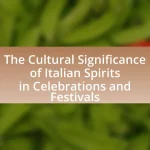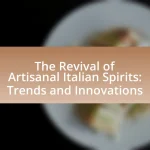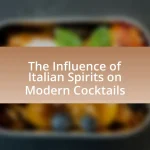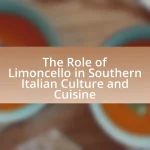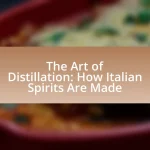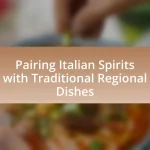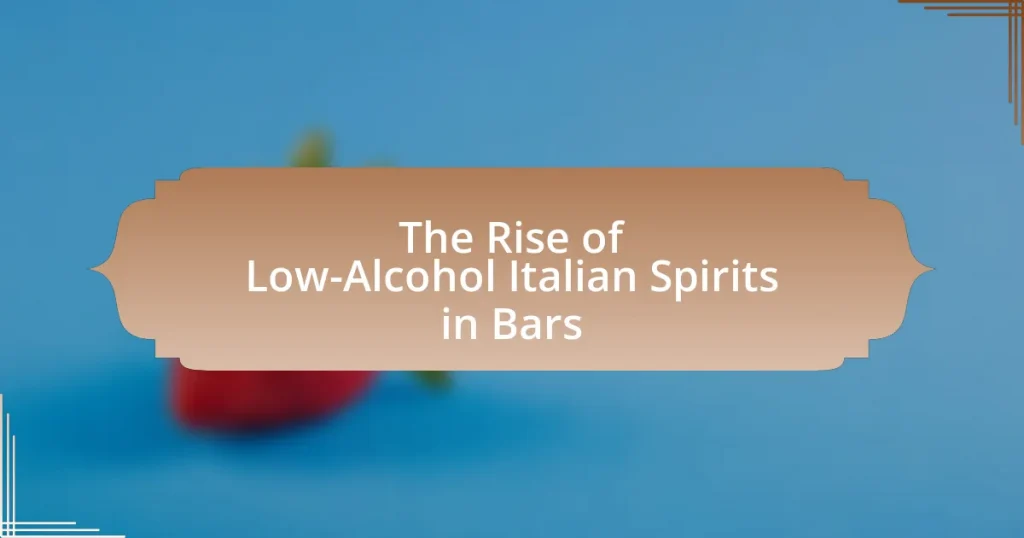Low-alcohol Italian spirits, defined as beverages with an alcohol by volume (ABV) of less than 20%, are gaining popularity in bars due to a growing consumer preference for healthier drinking options and moderation. This article explores the characteristics of these spirits, including vermouth and amaro, their role in modern cocktail culture, and the cultural shifts driving their demand. It also examines the challenges faced by low-alcohol options in the bar industry, such as consumer perceptions and regulatory issues, while highlighting effective marketing strategies and best practices for bars to successfully integrate these beverages into their offerings.
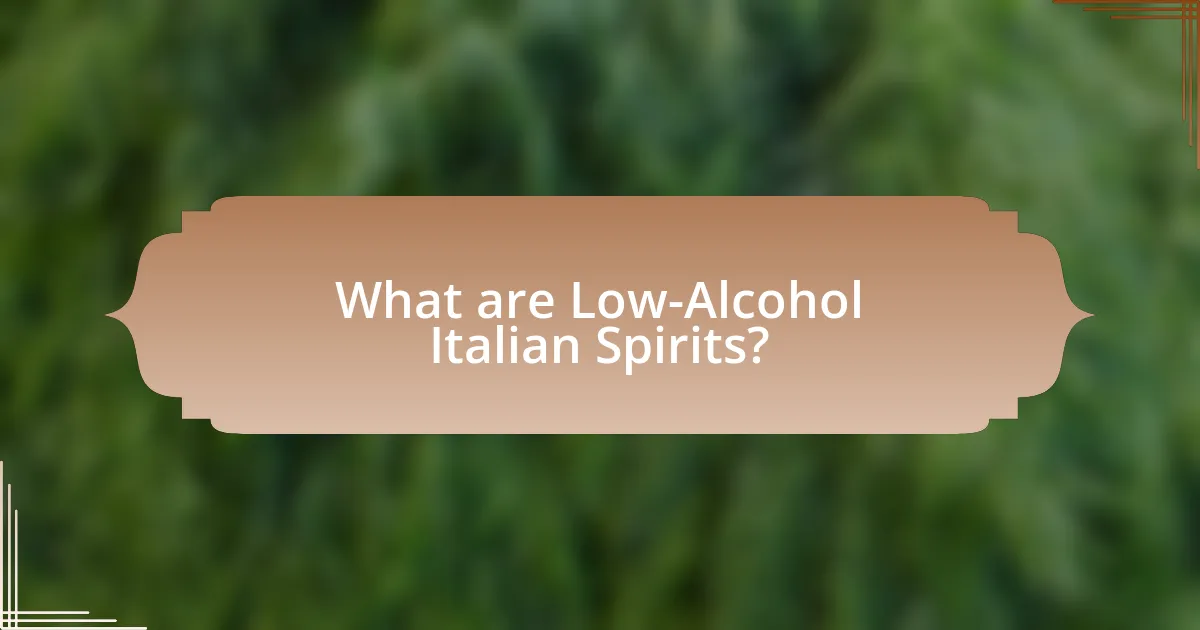
What are Low-Alcohol Italian Spirits?
Low-alcohol Italian spirits are beverages that typically contain an alcohol by volume (ABV) of less than 20%. These spirits include products like vermouth, amaro, and aperitivo, which are often used in cocktails or enjoyed on their own. The trend towards low-alcohol options reflects a growing consumer preference for lighter drinking experiences, particularly in social settings like bars. For instance, vermouth, a fortified wine flavored with various botanicals, has an ABV ranging from 15% to 18%, making it a popular choice for those seeking lower alcohol content. This shift is supported by market research indicating an increase in demand for low-alcohol beverages, aligning with health-conscious drinking habits.
How are Low-Alcohol Italian Spirits defined?
Low-alcohol Italian spirits are defined as beverages that contain an alcohol by volume (ABV) of 0.5% to 15%. This classification includes a variety of traditional and modern Italian drinks, such as vermouth and aperitifs, which are designed to be enjoyed in social settings with lower alcohol content compared to standard spirits. The rise in popularity of these beverages is supported by changing consumer preferences towards moderation and health-conscious choices, reflecting a broader trend in the beverage industry.
What is the alcohol content range for these spirits?
The alcohol content range for low-alcohol Italian spirits typically falls between 15% and 30% ABV (alcohol by volume). This range is consistent with various traditional Italian spirits, such as vermouth and amaro, which are designed to be enjoyed in moderation. For instance, many vermouths have an ABV around 15-18%, while certain amari can reach up to 30% ABV. This lower alcohol content aligns with the growing trend in bars to offer lighter, more sessionable drinking options, catering to consumer preferences for lower-alcohol beverages.
What distinguishes Low-Alcohol Italian Spirits from traditional spirits?
Low-Alcohol Italian Spirits are distinguished from traditional spirits primarily by their lower alcohol content, typically ranging from 10% to 20% ABV, compared to traditional spirits which usually exceed 20% ABV. This reduced alcohol level allows for a lighter drinking experience, catering to consumers seeking moderation without sacrificing flavor. Additionally, Low-Alcohol Italian Spirits often emphasize natural ingredients and complex flavor profiles, reflecting regional Italian traditions and culinary practices, which contrasts with the more straightforward flavor profiles of many traditional spirits.
Why is there a growing interest in Low-Alcohol Italian Spirits?
There is a growing interest in Low-Alcohol Italian Spirits due to increasing consumer demand for healthier drinking options and a shift towards moderation in alcohol consumption. This trend is supported by research indicating that 66% of consumers are seeking lower-alcohol alternatives to traditional spirits, reflecting a broader movement towards wellness and mindful drinking. Additionally, the unique flavors and cultural heritage of Italian spirits, such as vermouth and amaro, appeal to consumers looking for sophisticated yet lower-alcohol choices, further driving their popularity in bars and restaurants.
What cultural shifts are influencing this trend?
The cultural shifts influencing the trend of low-alcohol Italian spirits in bars include a growing emphasis on health and wellness, as well as a shift towards mindful drinking. Consumers are increasingly prioritizing lower alcohol options due to rising health consciousness, with studies indicating that 66% of adults are trying to reduce their alcohol intake. Additionally, the trend reflects a broader cultural movement towards sustainability and artisanal production, as many low-alcohol spirits are crafted using traditional methods and local ingredients, appealing to consumers’ desire for authenticity and quality.
How do health considerations impact consumer choices?
Health considerations significantly influence consumer choices by driving demand for products perceived as healthier options. As consumers become more health-conscious, they increasingly seek beverages with lower alcohol content, such as low-alcohol Italian spirits, which are often marketed as lighter and more suitable for social occasions without compromising well-being. Research indicates that 66% of consumers are trying to limit their alcohol intake, leading to a shift in purchasing behavior towards low-alcohol alternatives. This trend reflects a broader societal movement towards healthier lifestyles, where consumers prioritize wellness and moderation in their drinking habits.
What role do Low-Alcohol Italian Spirits play in modern bars?
Low-alcohol Italian spirits play a significant role in modern bars by catering to the growing demand for lighter drinking options. These spirits, such as Aperol and Campari, are often used in cocktails that emphasize flavor over alcohol content, appealing to health-conscious consumers and those seeking moderation. The trend aligns with a broader movement towards low-alcohol beverages, which has been supported by market research indicating a 30% increase in low-alcohol drink sales in the past five years. This shift allows bars to diversify their menus, attract a wider clientele, and enhance the overall drinking experience without compromising on taste.
How are bartenders incorporating these spirits into their menus?
Bartenders are incorporating low-alcohol Italian spirits into their menus by creating innovative cocktails that highlight the unique flavors of these beverages. For example, they often use vermouth and amaro as base ingredients in spritzes and low-ABV cocktails, appealing to consumers seeking lighter drinking options. This trend is supported by the growing demand for lower-alcohol beverages, with a report from the IWSR indicating a 30% increase in low-alcohol drink sales over the past five years. Additionally, bartenders are experimenting with seasonal ingredients and local produce to enhance the complexity of these cocktails, further integrating low-alcohol spirits into contemporary drinking culture.
What types of cocktails are popular with Low-Alcohol Italian Spirits?
Popular cocktails made with low-alcohol Italian spirits include the Spritz, Negroni Sbagliato, and Americano. The Spritz, typically made with Aperol or Campari, is a refreshing mix of the spirit, prosecco, and soda water, making it a favored choice in Italian aperitivo culture. The Negroni Sbagliato, a variation of the classic Negroni, substitutes gin with sparkling wine, resulting in a lighter drink. The Americano combines Campari, sweet vermouth, and soda water, offering a balanced flavor profile that appeals to those seeking lower alcohol content. These cocktails reflect the growing trend of low-alcohol options in bars, catering to consumers’ preferences for moderation while still enjoying flavorful beverages.
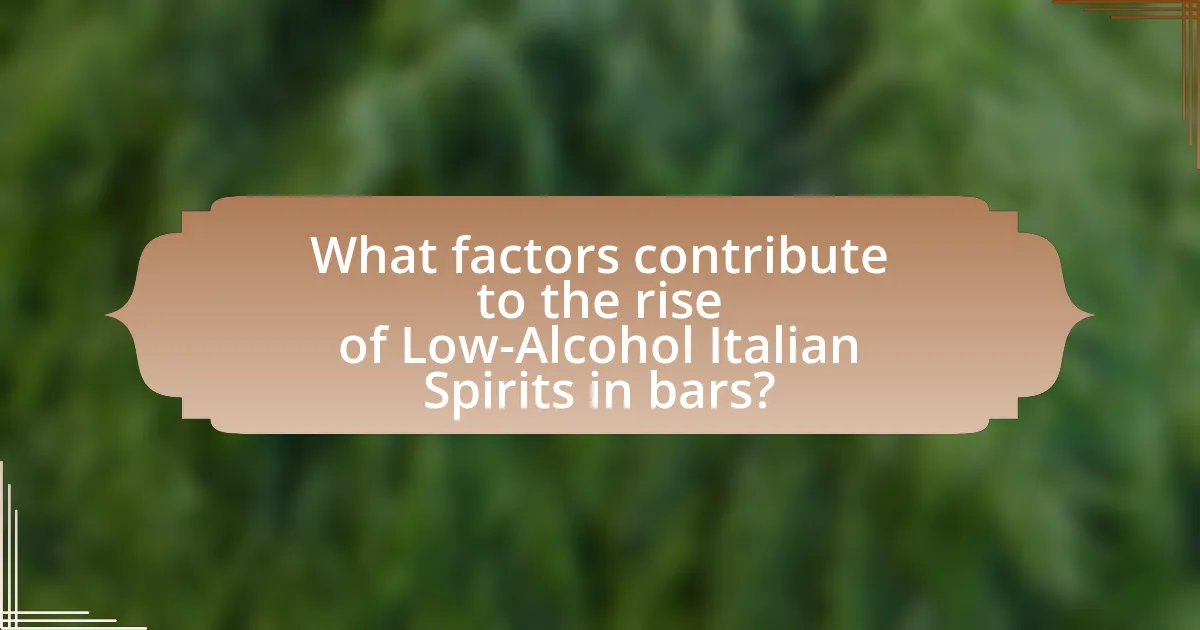
What factors contribute to the rise of Low-Alcohol Italian Spirits in bars?
The rise of Low-Alcohol Italian Spirits in bars is primarily driven by changing consumer preferences towards healthier drinking options. As awareness of health and wellness increases, consumers are seeking beverages that offer lower alcohol content while still providing flavor and complexity. Additionally, the trend towards moderation in alcohol consumption, influenced by movements such as Dry January and mindful drinking, has led to a growing demand for low-alcohol alternatives. The Italian spirits market has responded by innovating and creating products that cater to these preferences, such as vermouths and aperitifs with reduced alcohol levels. This shift is supported by market research indicating that low-alcohol beverages are gaining traction, with sales in this category increasing significantly over recent years.
How does consumer demand shape the availability of these spirits?
Consumer demand directly influences the availability of low-alcohol Italian spirits in bars by prompting suppliers to stock more of these products. As consumers increasingly seek lower-alcohol options for health and wellness reasons, bars respond by expanding their menus to include a wider variety of these spirits. For instance, a report from the IWSR Drinks Market Analysis indicates that the low-alcohol segment is growing rapidly, with a projected increase in sales by 31% from 2020 to 2024. This shift in consumer preference drives producers to create and distribute more low-alcohol options, ensuring that bars can meet the evolving tastes of their clientele.
What demographic trends are driving this demand?
The demand for low-alcohol Italian spirits in bars is primarily driven by the increasing health consciousness among younger consumers. This demographic trend is characterized by a shift towards moderation in alcohol consumption, particularly among millennials and Generation Z, who prioritize wellness and are more likely to seek lower-calorie and lower-alcohol options. According to a 2021 survey by the International Wine and Spirits Record, 66% of millennials are actively trying to reduce their alcohol intake, which directly influences their purchasing decisions in bars. Additionally, the rise of social media has led to a culture that values experiences over excessive drinking, further propelling the demand for low-alcohol beverages.
How do consumer preferences influence bar offerings?
Consumer preferences significantly influence bar offerings by driving the demand for specific products, such as low-alcohol Italian spirits. As consumers increasingly seek healthier drinking options and lower alcohol content, bars adapt their menus to include these spirits, reflecting a shift in market trends. For instance, a survey by the Beverage Marketing Corporation indicated that 27% of consumers are actively reducing their alcohol intake, prompting bars to diversify their offerings to meet this demand. This trend not only caters to health-conscious patrons but also aligns with the growing popularity of Italian aperitifs, which are often lower in alcohol and emphasize flavor.
What marketing strategies are effective for promoting Low-Alcohol Italian Spirits?
Effective marketing strategies for promoting low-alcohol Italian spirits include targeted social media campaigns, collaborations with mixologists, and educational tastings. Targeted social media campaigns leverage platforms like Instagram and Facebook to reach health-conscious consumers, showcasing the unique flavors and cultural heritage of these spirits. Collaborations with mixologists can create signature cocktails that highlight low-alcohol options, appealing to consumers seeking innovative drinking experiences. Educational tastings in bars and restaurants can inform patrons about the benefits and versatility of low-alcohol spirits, enhancing consumer engagement and driving sales. These strategies align with the growing trend of moderation in drinking, supported by research indicating that 27% of consumers are reducing their alcohol intake for health reasons.
How do brands position themselves in the market?
Brands position themselves in the market by identifying their unique value propositions and differentiating themselves from competitors. This involves analyzing target demographics, market trends, and consumer preferences to create a distinct brand identity. For example, brands in the low-alcohol Italian spirits segment may emphasize quality ingredients, traditional production methods, or health-conscious benefits to appeal to consumers seeking lighter drinking options. Research indicates that effective brand positioning can lead to increased customer loyalty and market share, as seen in the growing popularity of low-alcohol beverages, which have seen a 30% increase in sales over the past five years according to industry reports.
What role does social media play in the promotion of these spirits?
Social media plays a crucial role in the promotion of low-alcohol Italian spirits by providing a platform for brands to engage directly with consumers and showcase their products. Through visually appealing content, brands can highlight the unique flavors and cultural heritage of these spirits, attracting a younger audience that values authenticity and experience. For instance, campaigns on platforms like Instagram and TikTok leverage user-generated content and influencer partnerships to create buzz and drive interest, leading to increased visibility and sales. According to a study by the Digital Marketing Institute, 73% of marketers believe that social media marketing has been effective for their business, underscoring its significance in promoting niche products like low-alcohol spirits.
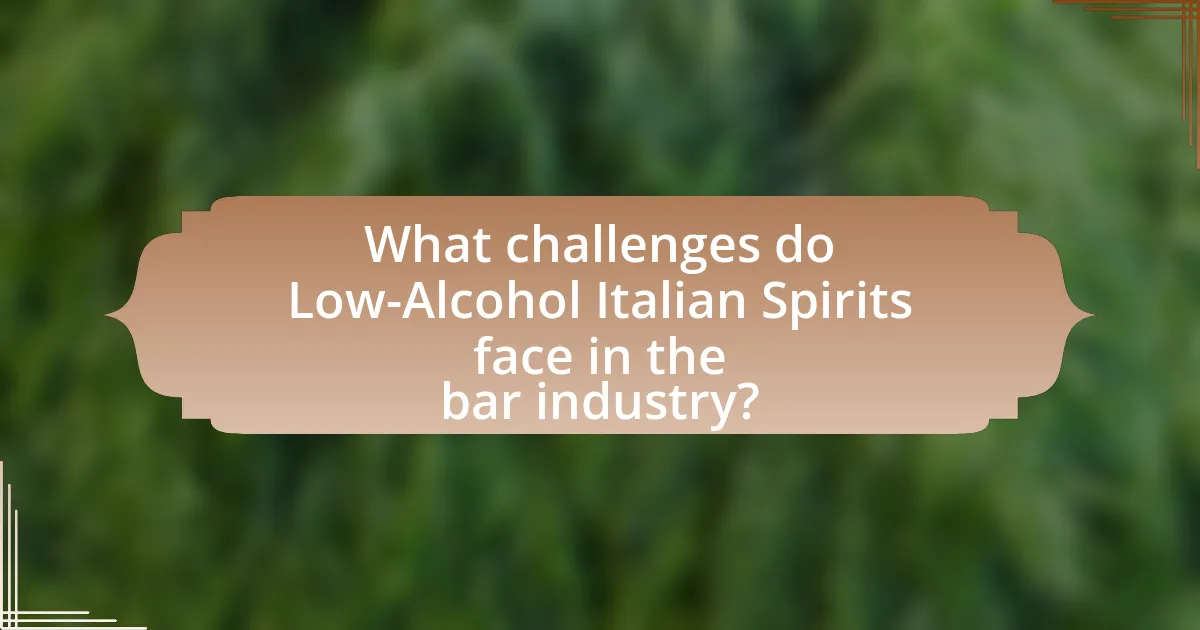
What challenges do Low-Alcohol Italian Spirits face in the bar industry?
Low-alcohol Italian spirits face significant challenges in the bar industry, primarily due to consumer perception and market positioning. Many consumers associate low-alcohol beverages with lower quality or less flavor, which can hinder their acceptance in a market that often prioritizes bold and robust flavors. Additionally, the bar industry is traditionally dominated by high-alcohol spirits, making it difficult for low-alcohol options to gain visibility and shelf space.
Furthermore, bartenders may lack familiarity with low-alcohol Italian spirits, leading to a limited ability to create innovative cocktails that highlight these products. According to a 2022 report by the International Bartenders Association, only 15% of bartenders felt confident in mixing low-alcohol cocktails, which directly impacts the promotion and sales of these spirits in bars. These factors collectively contribute to the challenges faced by low-alcohol Italian spirits in gaining traction within the competitive bar landscape.
How do traditional perceptions of alcohol affect acceptance?
Traditional perceptions of alcohol significantly influence societal acceptance of various alcoholic beverages, including low-alcohol options. In cultures where alcohol is traditionally associated with social status, celebration, or masculinity, there may be resistance to accepting lower-alcohol alternatives, which are often perceived as less sophisticated or desirable. For instance, in Italy, where strong spirits have a long-standing cultural significance, the introduction of low-alcohol Italian spirits may face skepticism from consumers who equate higher alcohol content with quality and authenticity. Research indicates that cultural norms and values shape drinking behaviors, suggesting that acceptance of low-alcohol spirits will depend on shifting these traditional perceptions to embrace moderation and new drinking trends.
What misconceptions exist about Low-Alcohol Italian Spirits?
Low-alcohol Italian spirits are often misunderstood as lacking flavor or complexity compared to their higher-alcohol counterparts. This misconception overlooks the fact that many low-alcohol spirits, such as Aperol and Campari, are crafted with a rich blend of botanicals, herbs, and spices, providing a nuanced taste profile. Additionally, some believe that low-alcohol spirits are only suitable for casual drinking or daytime consumption, while in reality, they can be enjoyed in sophisticated cocktails and pair well with a variety of cuisines, making them versatile options for any occasion.
How can bars overcome resistance to these spirits?
Bars can overcome resistance to low-alcohol Italian spirits by educating customers on their unique flavors and versatility in cocktails. Providing tastings and featuring these spirits in signature drinks can enhance customer experience and acceptance. Research indicates that consumer education significantly influences purchasing decisions, with 70% of patrons more likely to try a new product when they receive information about its origin and uses. By integrating these spirits into popular cocktails and promoting them through social media and events, bars can effectively shift perceptions and increase demand.
What regulatory issues impact the sale of Low-Alcohol Italian Spirits?
The sale of low-alcohol Italian spirits is impacted by regulatory issues such as labeling requirements, taxation, and alcohol content restrictions. In the European Union, spirits must comply with specific labeling regulations that dictate the information presented on packaging, including alcohol content and ingredients. Additionally, taxation policies vary by country, affecting pricing and market accessibility. For instance, Italy imposes different tax rates on alcoholic beverages based on their alcohol by volume (ABV), which can influence the competitiveness of low-alcohol options. Furthermore, regulations regarding the maximum allowable ABV for products marketed as low-alcohol can restrict the formulation and marketing strategies of producers.
How do different countries regulate low-alcohol beverages?
Different countries regulate low-alcohol beverages through varying legal frameworks that often define the alcohol content threshold for classification. For instance, in the European Union, beverages containing less than 1.2% alcohol by volume (ABV) can be marketed as non-alcoholic, while countries like the United States classify beverages with less than 0.5% ABV as non-alcoholic. Additionally, some countries impose specific labeling requirements and age restrictions for the sale of low-alcohol products. For example, in Australia, low-alcohol beverages are subject to the same regulations as regular alcoholic drinks, including taxation and advertising restrictions. These regulatory approaches reflect cultural attitudes towards alcohol consumption and public health considerations.
What labeling requirements must be met for these spirits?
Spirits must meet specific labeling requirements that include the name of the product, the alcohol content, and the country of origin. Additionally, labels must indicate whether the spirit is produced using traditional methods or ingredients, and any health warnings mandated by law must be present. These requirements ensure transparency and consumer safety, as outlined by regulations from governing bodies such as the Alcohol and Tobacco Tax and Trade Bureau (TTB) in the United States and similar organizations in other countries.
What are the best practices for bars to successfully integrate Low-Alcohol Italian Spirits?
Bars can successfully integrate low-alcohol Italian spirits by creating a diverse cocktail menu that highlights these beverages, training staff on their unique characteristics, and promoting them through targeted marketing strategies. A diverse cocktail menu allows bars to showcase the versatility of low-alcohol Italian spirits, such as vermouth and amaro, which can be used in various classic and innovative cocktails. Training staff ensures they can effectively communicate the flavor profiles and benefits of these spirits to customers, enhancing the overall experience. Additionally, targeted marketing strategies, including social media campaigns and special events, can raise awareness and attract customers interested in low-alcohol options. These practices are supported by the growing consumer trend towards moderation and health-conscious drinking, as evidenced by a 2021 report from the IWSR, which noted a 30% increase in low-alcohol beverage consumption globally.
How can bars educate staff about these spirits?
Bars can educate staff about low-alcohol Italian spirits through structured training programs that include tastings, workshops, and informational sessions. These programs should focus on the history, production methods, and flavor profiles of the spirits, enabling staff to articulate their unique characteristics to customers. For instance, providing hands-on experience with the spirits allows staff to understand their applications in cocktails, enhancing their ability to recommend drinks effectively. Additionally, utilizing resources such as industry publications and expert-led seminars can further deepen staff knowledge, ensuring they are well-informed about trends and consumer preferences in the growing market of low-alcohol options.
What tips can enhance customer experience with Low-Alcohol Italian Spirits?
To enhance customer experience with low-alcohol Italian spirits, bars should focus on offering a diverse selection of these beverages, ensuring quality and authenticity. Providing detailed tasting notes and pairing suggestions can help customers appreciate the unique flavors and characteristics of each spirit. Additionally, staff training on the history and production methods of low-alcohol Italian spirits can enrich customer interactions, fostering a deeper connection to the drinks. Engaging customers through themed events or tastings can also elevate their experience, making it more memorable. These strategies are supported by the growing trend of consumers seeking lower-alcohol options for a more mindful drinking experience, as evidenced by market research indicating a 30% increase in demand for low-alcohol beverages in recent years.
